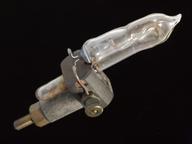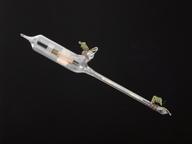







Spark gap or knob coherer, unknown maker, England, 1889. Used by Sir Oliver Lodge to first show the coherer effect and detect electric surgings by closing the circuit of a galvanometer during experiments on lightning guards.
Spark gap or knob coherer, unknown maker, England, 1889. Used by Sir Oliver Lodge to first show the coherer effect and detect electric surgings by closing the circuit of a galvanometer during experiments on lightning guards.
This spark-gap coherer, originally used for experiments on lightning guards, was used by Oliver Lodge in 1889 to detect weak electromagnetic waves. Lodge had observed that the knobs or points used as lightning protectors could become fused together when lightning struck nearby. He found that a very weak spark was enough to create the effect, as long as the surfaces were close enough. Lodge used this device in connection with a bell and a battery, to show the effect of electromagnetic waves. He called this device a coherer, a name which was subsequently applied to all detectors where the action depends upon a light and delicate contact.
Details
- Category:
- Radio Communication
- Object Number:
- 1924-36
- Materials:
- glass, brass (copper, zinc alloy) and textile
- Measurements:
-
overall: 200 mm x 55 mm x 30 mm, 4.91 kg
- type:
- coherer
- credit:
- Donated by Mr. Oliver Lodge [Grandson of Sir Oliver Lodge]




